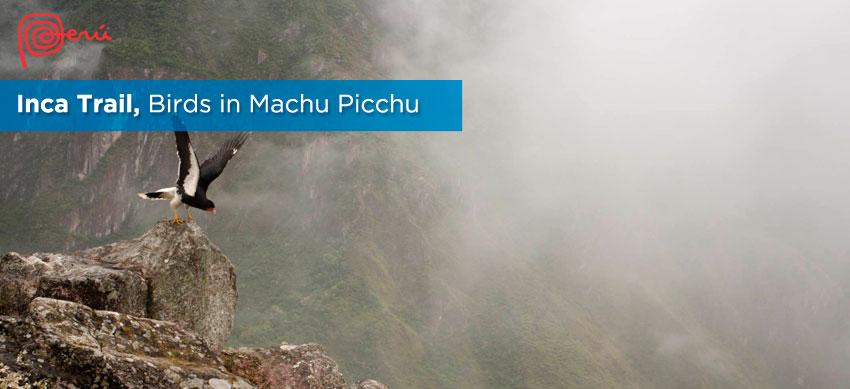
Inca Trail: A Birdwatcher’s Paradise
 The Machu Picchu Historical Sanctuary contains an impressive diversity of avifauna for such a compact area. This is due to the rapid succession of climatic zones in the Sanctuary. In Machu Picchu we find altitudes ranging from above 6,000 meters to 1,725 meters, from high puna grassland to humid subtropical cloud forest. Many bird species in the Andes have relatively small altitudinal ranges, and each habitat has species found in no other zone. Coupled with the microclimate created by the Urubamba Gorge, this creates great diversity—and a paradise for the birdwatcher.
The Machu Picchu Historical Sanctuary contains an impressive diversity of avifauna for such a compact area. This is due to the rapid succession of climatic zones in the Sanctuary. In Machu Picchu we find altitudes ranging from above 6,000 meters to 1,725 meters, from high puna grassland to humid subtropical cloud forest. Many bird species in the Andes have relatively small altitudinal ranges, and each habitat has species found in no other zone. Coupled with the microclimate created by the Urubamba Gorge, this creates great diversity—and a paradise for the birdwatcher.
As of 1995 approximately 375 species of birds are known in the sanctuary, of which around 200 can be readily observed while walking the Inca Trail. Without doubt further observations in remoter corners will add yet more species to this impressive list.
In the rain shadows of the intermontane valleys we find a dry climate characterized by short, scattered trees, shrubs and cacti. An early morning walk in this habitat, such as near Llaqtapata at the start of the Inca Trail, will reveal a variety of interesting birds. Partridge-like Andean Tinamous whistle from grassy fields and Torrent Ducks brave the whitewater of the rivers, swimming up the class five rapids, often accompanied in August by several improbable balls of fluff—their ducklings! White-capped Dippers bounce from rock to rock, searching underwater for crustaceans clinging to the boulders.
Many species of Finches flit amidst the bushes and cacti, and Scarlet-fronted Parakeets wheel noisily overhead, easily visible with their bright green plumes, until they alight on a tree and seem to disappear, perfectly camouflaged in the foliage. Brightly-colored Hummingbirds compete for nectar where cacti and shrubs are flowering—Sparkling Violetears, Green-tailed Trainbearers, .Bearded Mountaineers and the world’s largest Hummingbird, the Giant Hummingbird. Be sure to get out early to see the birds, because there are few to see by 11:00 a.m., except for a brief preroosting flurry before dark.
Moving to higher altitudes we reach the bleak grasslands known as the puna. At dawn it is cold and as the sun rises it is easy to see many birds feeding as the temperature rises. Terrestrial Flycatchers known as Ground-tyrants fly from rock to rock in search of flying insects, and flocks of brightly-colored Yellow-finches spring out of the ichu grass as the shadow of a Mountain Caracara passes.
A short walk here will produce encounters with strangely named birds such as Cinclodes, Puna Ibis, Sierra-finches and Canasteros. Due to the abundance of diurnal rodents at this altitude (it is too cold for them to be nocturnal) there are many birds of prey, including the Puna Hawk, Cinereous Harrier, and Black-chested Buzzard-Eagle. Master of his environment, the Andean Condor soars majestically on wind currents, often traversing many miles without a single flap of his wings. Despite its grandeur the Condor is strictly a carrion eater; it is incapable of grasping prey with its chicken-like feet.
On sheltered slopes, usually above 3,800 meters, grows polylepis woodland. This habitat is extremely endangered due to cutting for firewood, yet contains some of the world’s rarest birds. These forests are usually isolated from other forest types and surrounded by puna grassland. Birds in this habitat include the White-browed Tit-spinetail, Tawny Tit-spinetail, Royal Cinclodes, Ash-breasted Tit-tyrant, Giant Conebill and an assortment of high-altitude Hummingbirds. Line-cheeked spinetails probe the mossy trunks and d’Orbigny’s Chat-tyrants flit from tree to tree. Polylepis forest is hard to get to, but rewarding once reached.
But it is in the cloud forest that the birdlife reaches its greatest diversity. This is the forest found in the lower Urubamba Gorge (where not deforested) and the final two days of the Inca Trail. Here birds can be seen in mixed feeding flocks, as many as thirty species together. A morning of birdwatching in the misty cloud forest may produce many of the following: Cock- of-the-Rock, Brown Tinamou, White-rumped Hawk, Andean Guan, White-throated Quail- Dove, Andean Parakeet, Scaly-naped Parrot, Collared Inca, Violet-throated Starfrontlet, Great Sapphirewing, Chestnut-breasted Coronet, Sapphire-vented Puffleg, Amethyst-throated Sunangel, Tyrian Metal-tail, Rufous-capped Thombill, Golden-headed Quetzal, Crested Quetzal, Masked Trogon, Gray-breasted Mountain Toucan, Ocellated Piculet, Crimson-mantled Woodpecker, Crimson-bellied Woodpecker, Spot-crowned Woodcreeper, Azara’s Spinetail, Marcapata Spinetail, Scribble-tailed Canastero, Pearled Treerunner, Streaked Tuftedcheek, Montane Foliage-gleaner, Buff-throated Treehunter, Variable Antshrike, Undulated Antpitta, Rufous Antpitta, Unicolored Tapaculo, Green and Black Fruiteater, Barred Fruiteater, Red-crested Cotinga, tyrannulets too numerous to list, flycatchers, tanagers, Green Jay, Mountain Wren, Inca Wren, Blue and White Swallow, Great Thrush, Andean Solitaire, Brown-capped Vireo, Dusky-green Oropendola, Mountain Cacique, Spectacled Redstart, and Slate-throated Redstart.
This is just a sample of the birds that may be seen in the cloud forest. The easiest time and place to see them is in the early morning along the railroad line between Puente Ruinas and Mandor, and along the rough trail half an hour’s walk up the Mandor Gorge.
By Inca Trail Machu Picchu - Last updated, 08-11-2021
Interested in the Inca Trail? Know more about Nature!
- Fauna during the Salkantay Trek
- Cloud forest of Machu Picchu – The geography of Machu Picchu
- The closest waterfalls of Machu Picchu
- How to avoid the environmental impact on the Inca Trail?
- Coca leaf, ideal for trekking in Peru
- The Cantuta flower. Where to find it on the Inca Trail?
